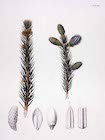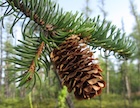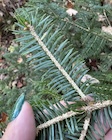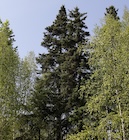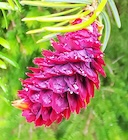Conservation Status

Picea jezoensis
(Siebold & Zucc.) Carrière (1855)
Common names
Yezo spruce; Jezo spruce; エゾマツ Ezo-matsu [Japanese]; 卵果鱼鳞云杉 yu lin yunshan [Chinese], Ель аянская [Russian]; sunku, carpi-shungu, or sunku-to-noma [Ainu]. Subsp. hondoensis is called Tohi [Japanese].
Taxonomic notes
There are two subspecies and a variety:
- Picea jezoensis subsp. hondoensis (Mayr) P.A.Schmidt (1988).
- Picea jezoensis subsp. jezoensis.
- Picea jezoensis var. koreana Uyeki (1942).
See POWO for synonymy, which is extensive, particularly for the type subspecies. There is also a named hybrid with Picea glehnii, Picea × notha Rehder, J. Arnold Arbor. 20: 85 (1939).
A robust molecular analysis, addressing almost all Picea taxa with multiple samples, placed P. jezoensis sister to P. sitchensis of North America in a clade that also included 2 other North American species, P. engelmannii and P. glauca. The distribution of P. jezoensis today appears to be a consequence of a dispersal event from North America through Beringia about 8.75 million years ago (Shao et al. 2019). It has been hypothesized that the Honshu population of P. jezoensis could have dispersed to Japan via the Korean peninsula, and that the Hokkaido population could have dispersed from Asia via Sakhalin; these landmasses were connected in the Pliocene and early Quaternary (Aizawa et al. 2007). This could explain the observed distribution of subspecies and variety. The same analysis found strong support for separation between the two subspecies of P. jezoensis, but did not evaluate variety koreana; it also found that some mitochondrial haplotypes are endemic to Japan, likely due to isolation on the islands of Honshu and Hokkaido. Aizawa et al. (2015) found evidence of mitochondrial introgression of P. jezoensis into P. glehnii, such that the two species now share two mitochondrial haplotypes.
Description
The type subspecies is a monoecious evergreen tree up to 35 m tall and 100 cm dbh. The bark is grayish brown, deeply fissured and peeling off in irregular scales. Branchlets are pale yellowish-brown, deeply grooved, and glabrous; pulvini are 0.5 mm long. Leaves are leathery, linear, flat, slightly keeled on both surfaces, 15-25 mm long, 1.5-2 mm wide, apex pointed, with two white stomatal bands on the upper surface; there are two resin canals two, near the lower surface. There are 1-3 pollen cones, terminal on previous year's shoots, cylindric, red-brown, 1.5-2 cm long, 6 mm across, with numerous stamens. Seed cones are solitary, terminal on previous year's shoots, cylindric, brown, pendant, 4-7 cm long, ca. 2 cm across. The seed scales are thinly woody, ovate or oblong-ovate, with an obtuse or rounded apex, slightly denticulate on upper margin, ca. 10 mm long, 6-7 mm wide. Bract scales are small, narrowly ovate, acute, laxly denticulate on upper margin, ca. 3 mm long. Seeds are obovate, brown, 2-2.5 mm long, 1.5 mm wide; wings oblong-ovate, pale brown, 5-6 mm long, 2-2.5 mm wide. The plant flowers in May to June and the cones ripen in September (Iwatsuki et al. 1995). See García Esteban et al. (2004) for a detailed characterization of the wood anatomy.
Subsp. hondoensis differs from the type in having dull red-brown bark that is shallowly fissured and peels off in small scales. The pulvini are smaller, ca. 0.3 mm long, and the leaves are also smaller, 8-15 mm long by 1.5 mm wide. The seed scales are ovate-rhomboid, 8-10 mm wide, and distinctly denticulate on the upper margin. Plants from Ozegahara (Fukushima and Gunma Prefectures) have gray-brown bark, deeply fissured and peeling off in irregular scales. This form has been named f. ozeensis Hayashi (Bull. Gov. For. Exp. Stn. no. 125: 72, t. 2 33, 1960) (Iwatsuki et al. 1995).
Var. koreana has pale yellowish young shoots and smaller cones (Iwatsuki et al. 1995 [as var. komarovii]).
Distribution and Ecology
The type subspecies is native in Japan: S Kuriles and Hokkaido; China: Heilongjiang; North Korea; and Russia: Ussuri, Sakhalin, the Kuriles, and central Kamchatka (Farjon 1990, Iwatsuki et al. 1995). In Japan, it occurs in subalpine forests at 40-1000 m elevation (Iwatsuki et al. 1995); in Russia, it occurs N along Sea of Okhotsk coast to Magadan as "an ecological counterpart of Sitka spruce" (Vladimir Dinets e-mail 1998.01.02). Hardy to Zone 2 (cold hardiness limit between -45.6°C and -40.0°C) (Bannister and Neuner 2001, variety not specified).
Var. komarovii is restricted to North Korea and Heilongjiang (Iwatsuki et al. 1995). Subsp. hondoensis is native only to Japan: central Honshu (southward from Tochigi Prefectura and northward from Nara Prefecture), in subalpine forests at elevations of 1400-2500 m (Iwatsuki et al. 1995).
Remarkable Specimens
A tree 48 m tall is reported from the Shantar Islands (Russia) (Vladimir Dinets e-mail 1998.01.02).
Ethnobotany
The Ainu made extensive use of this species, regarding it as one of the pirika chikuni, or “good trees”. The bark was used for roofs and walls of traditional houses. The trunk was used for making dugout canoes. The roots were used for binding boards to dugouts and in making bentwood boxes (Williams 2017). The wood was used to make a string instrument called at tonkori (Chikar Studio n.d.). The resin was used to secure arrowheads to the shaft of the arrow and to caulk canoes. The Ainu would hunt bear using traps armed with poisoned arrows; Picea jezoensis resin was used to seal the poison (extracted from Aconitum sinense) into the base of the arrow tip. The resin and the poison were both deified in recognition of their role in sustaining the Ainu hunting economy. The plant was also used for more positive medical uses: the sap, resin, or pitch was used treating wounds. In one tale a goddess helps a woman, who had been killed by a bear, find happiness in her afterlife. At one point, the goddess says to the woman, “this [pitch] is medicine from the gods; spread on your wounds and you’ll soon recover". As with Abies sakhalinensis its branches were tossed into the fire to drive off evil; they were also made into ritual staffs used to purify sled dogs. The needles were infused, a cloth dipped in the infusion, and the cloth placed over the head to cure influenza (Williams 2017 and sources cited therein).
Observations
No data as of 2025.01.23.
Remarks
The epithet refers to Jezo (or Yezo), an alternative name for Hokkaido.
Citations
Aizawa, M., H. Yoshimaru, H. Saito, T. Katsuki, T. Kawahara, K. Kitamura, F. Shi, and M. Kaji. 2007. Phylogeography of a northeast Asian spruce, Picea jezoensis, inferred from genetic variation observed in organelle DNA markers. Molecular Ecology 16(16):3393–3405. doi.org/10.1111/j.1365-294X.2007.03391.x.
Aizawa, M., H. Yoshimaru, M. Takahashi, T. Kawahara, H. Sugita, H. Saito, and R. N. Sabirov. 2015. Genetic structure of Sakhalin spruce (Picea glehnii) in northern Japan and adjacent regions revealed by nuclear microsatellites and mitochondrial gene sequences. J. Plant. Res. 128:91–102. doi.org/10.1007/s10265-014-0682-7.
Chikar Studio. [no date]. Chikar Studio Profile. http://www.tonkori.com/profile/index.php, accessed 2010.12.20.
Farjon, Aljos. 1990. Pinaceae: drawings and descriptions of the genera Abies, Cedrus, Pseudolarix, Keteleeria, Nothotsuga, Tsuga, Cathaya, Pseudotsuga, Larix and Picea. Königstein: Koeltz Scientific Books.
Farjon, Aljos. 1993. Names in current use in the Pinaceae (Gymnospermae) in the ranks of genus to variety. Pp. 105-146 in W. Greuter (ed.), NCU-2 Names in Current Use in the Families Trichocomaceae, Cladoniaceae, Pinaceae, and Lemnaceae, Regnum Vegetabile, vol. 128. Koeltz Scientific Books, Königstein.
Schmidt, P. A. 1988. Haussknechtia, Mitt. Thüring. Bot. Ges. 4:38. Available: Haussknechtia, accessed 2025.01.23.
Shao, Cheng-Cheng, Ting-Ting Shen, Wei-Tao Jin, Han-Jie Mao, Jin-Hua Ran, and Xiao-Quan Wang. 2019. Phylotranscriptomics resolves interspecific relationships and indicates multiple historical out-of-North America dispersals through the Bering Land Bridge for the genus Picea (Pinaceae). Molecular phylogenetics and evolution 141: 106610.
Siebold, P.F.v. and J.G. Zuccarini. 1842–1870. Flora Japonica sive, Plantae Quas in Imperio Japonico Collegit, Descripsit, ex Parte in Ipsis Locis Pingendas Curavit. Sectio Prima Continens Plantas Ornatui vel Usui Inservientes. Digessit J. G. Zuccarini. Volumen secundum. 89 + 1 pp., 150 tab., Lugduni Batavorum [Leiden] (p. 19, t. 110).
Uyeki. 1942. Journal of Korean Forestry Society, Suwon. 206:12.
Williams, Dai. 2017. Ainu Ethnobiology. Tacoma, WA: Society of Ethnobiology. ISBN 978-0-9887330-7-7 (PDF). Pp. 34, 120, 177, 178.
See also
Elwes and Henry 1906-1913 at the Biodiversity Heritage Library (as P. ajanensis and P. hondoensis, since reduced to synonymy). This series of volumes, privately printed, provides some of the most engaging descriptions of conifers ever published. Although they only treat species cultivated in the U.K. and Ireland, and the taxonomy is a bit dated, still these accounts are thorough, treating such topics as species description, range, varieties, exceptionally old or tall specimens, remarkable trees, and cultivation. Despite being over a century old, they are generally accurate, and are illustrated with some remarkable photographs and lithographs.
Tomoko Otake. 2005. Sacred sounds of Ainu tonkori resurrected. Japan Times, https://www.japantimes.co.jp/culture/2005/06/22/music/sacred-sounds-of-ainu-tonkori-resurrected/#.XHcq6FNKjUI, accessed 2019.02.27.
